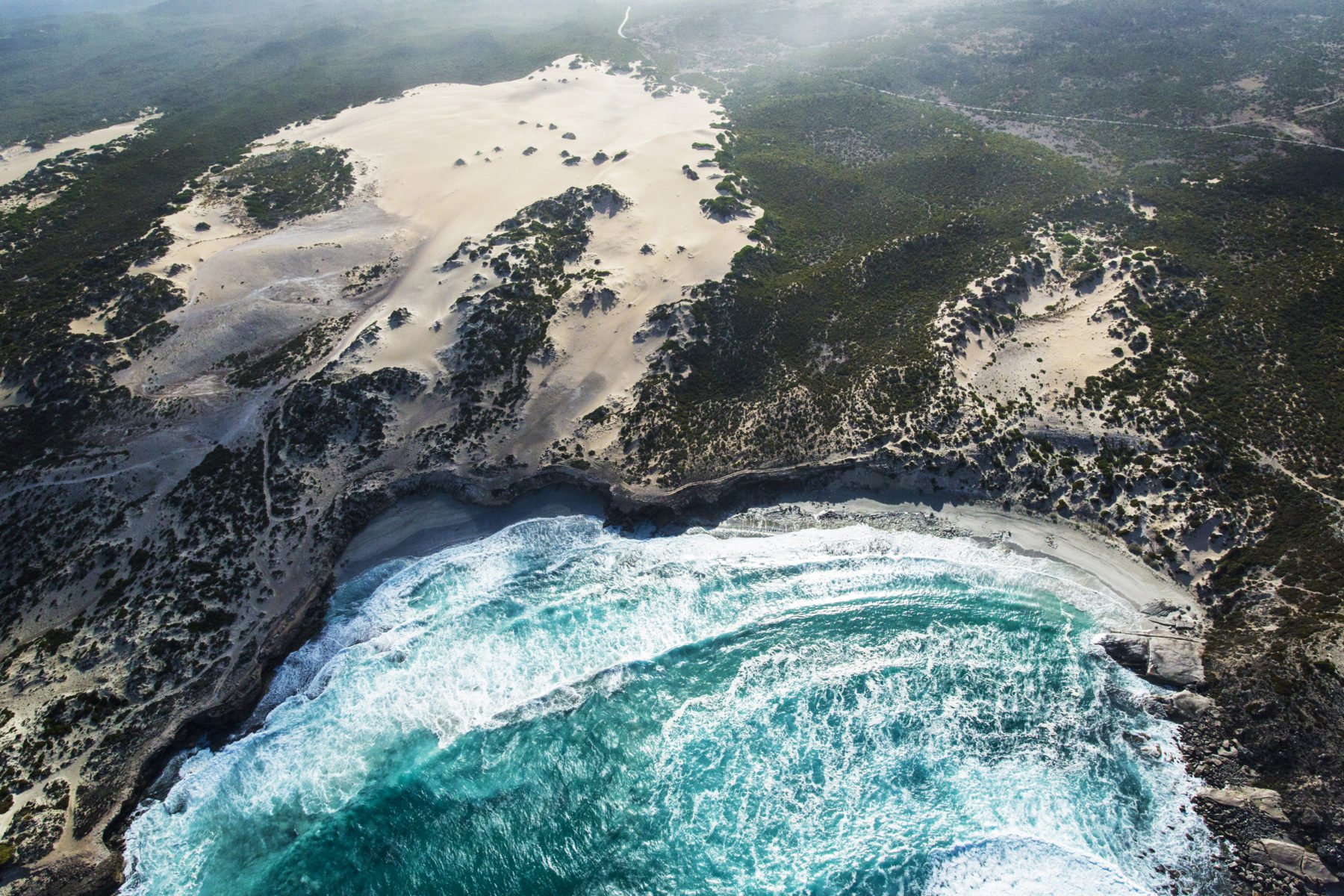Eyre Peninsula

The Eyre Peninsula’s tip abounds in startling contrasts. The two huge hammerhead peninsulas, forming Lincoln and Coffin Bay national parks, jut to the east and west, respectively. These geological wonders give the region an uncanny symmetry. Both sport natural harbours and discreet hideaway bays. But each turns to the open ocean with wildly exposed cliffs and beaches – plus a slew of menacing reefs, islands and unyielding capes, not to mention freakish currents and waves.
The driver for this multi-barbed coastline is a geological double act. The Eyre Peninsula is part of the Gawler Craton, one of the most stable hunks of our continental crust. It’s home to some of Australia’s oldest rocks, dating back as far as 2.44 billion years.
This ancestry is reflected in the distinctive dome-like hills that dot the peninsula, as well as formations such as the Marble Range looming out of vast wheat paddocks north of Coffin Bay.
Meanwhile, along the foot of the coast, these crystalline-tough basement granites hold fast as robust headlands and broad, wave-cut terraces. This sturdy frontline takes the brunt of the ocean’s heaviest blows, and protects the much younger layers of limestone above. Born out of wind-blown calcareous dunes, this limestone caps vast areas of the coast and hinterland. Scalloped cliffs of pale, biscuit-coloured stone are the peninsula’s gritty signature.

WITH SUCH AN ARRAY of coastal haunts on their doorstep, it’s little wonder the lives of Port Lincoln’s 16,418 residents are so entwined with the sea. On any weekend, boardriders by the dozen are catching breaks at Sleaford and Fishery bays. Meanwhile, across the peninsula, the waters of Boston Bay will be flecked with cabin cruisers, tinnies and white sails of all sizes. In this port, regattas unfold against a backdrop of tuna boats toing and froing, and hefty bulk carriers loading grain.
Even Memory Cove – hidden at the end of a rough four-wheel-drive track in a wilderness protection area – is a popular spot for local campers and boaties. Despite its sombre back story – it’s named for lost crew members from Matthew Flinders’ 1802 expedition – the cove is bright and lively.
Birdlife abounds. In a few strides through the mallee you can step from a world of New Holland honeyeaters, silvereyes and Port Lincoln parrots to the beachfront domain of hooded plovers and oystercatchers, with a white-bellied sea-eagle rarely far from view. It’s seventh heaven for twitchers.
To South Australians, the Eyre Peninsula is better known as the west coast. It’s talked about as a larger-than-life place that’s home to vast wheat farms, raging surf, sharks and sudden storms. The region’s grain harvest might be a whopping 2 million tonnes, but above all else the west coast is synonymous with big-time fishing.
The entire region boasts an astonishing bounty – from abalone and sand crabs to southern rock lobsters (known to South Australians as crayfish), mussels, scallops, oysters and a host of prized scale-fish species.
The Great South Australian Coastal Upwelling System brings cold, nutrient-rich waters billowing to the surface from the continental shelf. These dissolved nutrients are the foundation links in the marine food chain – including the pilchards that bluefin tuna feast on. Among the other beneficiaries are the famed oysters of Coffin Bay. This network of enclosed waterways is mollusc paradise. Clean, unspoilt waters and daily tides deliver all the necessary goodies to sustain the area’s 40-odd oyster farmers.
With its jetties, waterfront shacks, caravan park and general store, Coffin Bay’s township is the quintessential laid-back fishing village. It’s a seafood frontier blessed with delicious coastal produce.
From the secure footing of a lookout on terra firma, the landscape shifts of the Eyre Peninsula are dramatic, even unnerving. But that’s nothing compared with the view from the deck of a small boat beneath cliffs in a pitching sea.

Moreover, in certain conditions, even the most benign waters can become exposed and treacherous. Then all it takes is a sudden punch of wind, a wrong move or a tidal rip for disaster to strike.
There’s no better place to contemplate the raw power of the Southern Ocean at work than Reef Point, in Coffin Bay NP’s south-west. Here a clutch of headlands and reefs faces the incoming barrage.
As darkness closes in, the masthead light of a small fishing boat appears out to sea. With a storm front approaching, its crew is heading north, hoping to make the safe haven of Coffin Bay. Its light keeps swaying with the toss of the swell until it finally disappears up the coast, hidden in a relentless haze of waves and spray.
The Eyre Peninsula has a history built on wild seas, shipwrecks and seafood, and its ocean-faring folk will regale you with stories of all when you visit. Just be sure your belly can stomach the ride.

Go beyond
Stay
Surrounded by golden sand, red rocks, pulsing ocean and all the wildlife within, Camel Beach House is an off-grid, 102ha wilderness property located at the southern end of a spectacular coastal area known as the Chain of Bays (Venus Bay to Streaky Bay) on the Eyre Peninsula.
Visit: camelbeachhouse.com.au
Eat
Have a penchant for oysters? Then make Coffin Bay your preferred lunchtime spot. Try an oyster farm tour before sitting down to a serve at one of the oceanfront seafood restaurants, including Oyster Bar, Oyster HQ and Coffin Bay Yacht Club.
Visit: oysterfarmtours.com.au
Walk
Enjoy the rich granite hues and sandy
beaches of the northern tip of Lincoln NP on this 4.9km walk from Fisherman Point to Cape Donington. The trail offers panoramic views of Port Lincoln, Boston Bay and the off-
shore islands and takes in Donington
Cottage, built about 1899, and Cape
Donington Lighthouse.
Visit: parks.sa.gov.au/parks/lincoln-national-park

Go wild
Experience the untouched and remote beauty of the Eyre Peninsula. From spectacular coastal landscapes to the wildly beautiful outback, and the wildlife that calls them home, you’ll revel in the diversity of this genuine ocean-to-outback tour.
Visit: australiangeographic.com.au/exceptional-travel-
experiences

